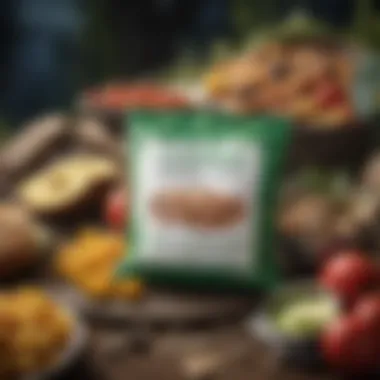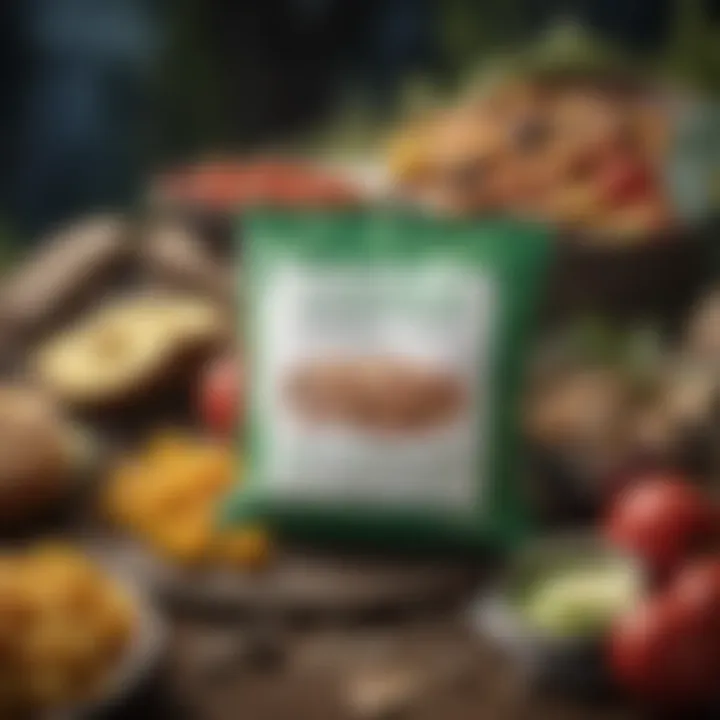Essential Non-Perishable Foods for Camping Adventures


Intro
Camping is an adventure that beckons those who seek the great outdoors. However, planning meals can be a challenge, especially when the goal is to pack efficiently without sacrificing taste and nutrition. Non-perishable foods serve as the backbone of outdoor cooking, offering sustenance that lasts and is easy to prepare under varying conditions. This guide aims to provide a thorough exploration into non-perishable camping food, ensuring that outdoor enthusiasts can enjoy fulfilling meals without the worry of spoilage.
Finding the right balance between convenience and quality is crucial. Whether you are embarking on a weekend excursion or a longer backpacking trip, understanding the types of non-perishable foods available will aid in strategic meal planning. This article will cover essential categories, practical preparation tips, and considerations tailored for different camping scenarios.
"Proper nutrition while camping can enhance your experience. Choosing the right food not only keeps you energized but also satisfies your appetite for adventure."
Emphasis on Nutritional Value
a pivotal aspect of choosing camping foods lies in their nutritional value. Energy-dense foods can help sustain you during lengthy hikes or outdoor activities. Foods that are rich in proteins, carbohydrates, and healthy fats should be prioritized to fuel your body adequately.
With the vast array of options available, it’s vital to delve into specific categories of non-perishable foods. The upcoming sections will guide you through these selections, beginning with the foundational aspects of meal planning.
Understanding Non-Perishable Foods
When embarking on a camping trip, understanding non-perishable foods is essential. This knowledge not only aids in meal planning but also ensures that you make the most of your outdoor experience. Non-perishable foods provide the convenience of easy storage and transport while maintaining nutritional value, making them invaluable for every camping adventure.
Definition of Non-Perishable Foods
Non-perishable foods are items that do not require refrigeration and can be stored for extended periods. They are classified based on their ability to withstand various environmental conditions. Some common types include canned goods, dried foods, grains, and certain snacks. These foods often have a long shelf life, which means they do not spoil quickly. Consequently, campers can rely on them during their trips without worrying about food safety.
Importance in Camping
The importance of non-perishable foods in camping cannot be overstated. They are practical and versatile, providing maintainable nutrition without the need for advanced preparation. Campers can carry these items easily, saving valuable space in their packs. Moreover, since many outdoor settings lack reliable access to fresh foods, non-perishable options ensure that you have a sufficient supply of essentials. This reduces the risk of running out of food during an outing.
In addition, these foods allow for creativity in meal preparation. Campers can mix, match, and create various dishes without the complexities associated with fresh ingredients. As a result, meal variety remains high, contributing to a satisfying camping experience.
"Choosing the right non-perishable foods empowers outdoor enthusiasts to focus on enjoying nature rather than worrying about basic needs."
By understanding the definition and significance of non-perishable foods, you set the stage for thoughtful meal planning. Making informed choices about what foods to bring can greatly impact the success and enjoyment of your outdoor excursions.
Benefits of Non-Perishable Foods for Camping
Non-perishable foods serve a vital role in camping, offering advantages that align perfectly with the unpredictable nature of outdoor activities. Understanding these benefits can enhance the camping experience, ensuring that individuals are well-prepared for their journeys. This section discusses three major benefits: long shelf life, ease of transport, and nutritional value. Each element addresses specific needs and considerations for outdoor enthusiasts.
Long Shelf Life
One of the most appealing aspects of non-perishable foods is their long shelf life. Unlike fresh produce, which spoils quickly, non-perishables can last for months, even years, when stored properly. This longevity means you can buy in bulk and have a reliable supply for multiple trips without frequent replacements. When planning a camping trip, especially one that lasts several days or even weeks, having food that will maintain its quality over time is essential. This reduces the worry about checking expiration dates while in the wilderness.
Moreover, the durability of non-perishable foods plays a huge role in emergencies. If campers find themselves delayed by weather or unforeseen circumstances, having a stable food supply can be crucial for maintaining energy and morale. Some examples include canned vegetables, dried beans, or pasta. These options can often be eaten straight from the can, making them convenient as well as practical.
Ease of Transport
When approaching any outdoor adventure, the ease of transport is a significant factor. Non-perishable foods are typically lightweight and compact, making them ideal for backpackers and car campers alike. They do not require refrigeration, which not only saves space but also eliminates the need for bulky coolers or ice packs.
Packing non-perishable foods allows campers to maximize the efficiency of their supplies. Items like energy bars, trail mix, and vacuum-sealed meals fit snugly in bags and offer a variety of quick nutrition. Moreover, many of these foods come in resealable or easy-to-carry packaging, further simplifying meal planning.
With less weight to carry, campers can focus on enjoying the outdoor experience rather than stressing about supplies. Reducing transport loads allows for more room for other gear or better packing efficiency, which is particularly important in rugged terrains.
Nutritional Value
Addressing the nutritional value of non-perishable foods is crucial. While some may assume that long-lasting foods are low in nutrients, this is not necessarily the case. Many non-perishable options are designed to retain their nutritional content. For instance, canned fruits and vegetables often maintain their vitamins and minerals, providing essential nutrients.
When selecting non-perishable foods for camping, it is wise to prioritize options that are rich in fiber, protein, and healthy fats. Foods like nuts, seeds, and whole grains not only provide energy but also keep hunger at bay.
"A well-balanced diet is crucial for sustaining energy during outdoor activities, and non-perishable foods can offer high-quality nutrition if chosen wisely."
Categories of Non-Perishable Camping Food


Non-perishable camping foods serve as the backbone of meal planning for outdoor enthusiasts. They are essential for long-lasting nutrition and energy needs during camping expeditions. For anyone venturing into the wilderness, understanding the various categories of these foods is crucial. Each type possesses unique attributes that cater to different tastes, meal preferences, and nutritional requirements. Knowing these can significantly enhance the camping experience, ensuring that energy and sustenance are easily attained.
Canned Foods
Types of canned foods
Canned foods are a prominent choice in the realm of non-perishable camping options. They provide a wide range of selections, from vegetables and beans to meats and soups. The processing of these foods ensures a long shelf life, making them ideal for camping. Key characteristics include readiness-to-eat meals and convenience, as most canned goods merely require heating or can be consumed directly from the can.
However, one drawback could be their weight. Cans can add significant bulk to a backpack. Nonetheless, they remain a beneficial option due to their durability and diversity. Those who prefer savory meals will find canned goods essential for balanced camping fare.
Choosing nutrient-dense options
When selecting canned foods, opting for nutrient-dense options is critical. These can include canned beans, fish, or fruits in their natural juices. Why is this important? Nutrient-rich foods help maintain energy levels during excursions where physical activity is high.
A unique feature of these options is their capability to provide essential vitamins and minerals while being shelf-stable. Some disadvantages include potential high sodium levels, which can lead to dehydration if not balanced with adequate water consumption. So, while choosing canned foods, awareness of their nutritional profile is vital to sustained health on the trail.
Dried Foods
Types of dried foods
Dried foods are another critical category of non-perishable camping food. This can include fruits, vegetables, and various meats. Their lightweight nature and compact storage make them particularly attractive for long hikes. They offer a concentrated source of energy and are often higher in fiber, which aids digestion.
Similarly, they are also energy-efficient to carry, as they require less space. However, one challenge with dried foods is the need for rehydration before eating in most cases. This may limit their immediate use without proper preparation, but they still make an indispensable addition to any camping menu.
Rehydration methods
Rehydration methods for dried foods can vary widely. A common approach is to soak the dried item in water for an hour or more or to cook them directly with water over a heat source. Quick-cooking options are often available that only require boiling water, compelling for those in need of speedy meal options in the outdoors.
The beauty of these methods lies in their simplicity. However, it’s pertinent that campers are aware of time requirements and water usage. Not being prepared may lead to issues when time is of the essence during the trip.
Snacks and Energy Bars
Choosing healthy snacks
Snacks play a vital role in maintaining energy levels between meals. Choosing healthy snacks ensures that these snacks are not only tasty but also nutritious. Popular options can include nut mixes, trail mixes, or energy gels. They are easy to carry and consume on the move.
The key characteristic here is their ability to deliver quick energy without taking much time to prepare or eat. Being lightweight and portable is a significant advantage for outdoor activities. The downside is that some snack options can be high in sugar if not chosen carefully. A balanced approach to snacking will help keep one energized and satisfied throughout the adventure.
Homemade versus store-bought
When considering snacks, the choice between homemade and store-bought options comes into play. Homemade snacks allow for control over ingredients and can tailor nutrition levels to personal preferences. Options such as baked energy bars or dried fruit and nut mixtures can be made with little difficulty.
Store-bought options tend to provide convenience and variety for those lacking time or resources for homemade alternatives. However, they may come at a cost of unknown preservatives or artificial ingredients. Each choice presents its merits, and it would be wise for campers to weigh these aspects based on personal needs.
Grains and Pasta
Varieties of grains
Grains are often a staple in a camping diet. They provide essential carbohydrates for energy. Varieties include rice, quinoa, and whole-wheat pasta. The choice of grain impacts overall meal quality. Some grains, like quinoa, offer higher protein content compared to rice.
Their ease of storage and extended shelf life contributes to their popularity. The challenge here lies in preparation. Campers must be equipped with the knowledge for correctly cooking grains over a campfire or portable stove.
Cooking techniques without power
Cooking techniques without power can be a creative endeavor. Boiling grains using a camp stove or even cooking directly on a hot rock can serve as effective alternatives. These methods allow for adaptability in various outdoor conditions.
The main advantage is the flexibility it affords outdoor enthusiasts to enjoy multiple meals without reliance on electricity. However, it necessitates some technique and practice to ensure food is cooked properly.
Instant Meals


Types of instant meals available
Instant meals provide maximum convenience during outdoor excursions. These meals often include dehydrated or freeze-dried options that only need water for preparation. They range from soups and stews to complete entrees. The varied selection makes them popular among campers seeking quick meal solutions.
A key characteristic of instant meals is their ease of preparation and generally lightweight composition. However, some might contain additives that are not favored by health-conscious individuals, thus requiring scrutiny before selection.
Nutritional considerations
Nutritional considerations for instant meals should not be overlooked. While they offer convenience, it’s important to read labels. Some options can be high in sodium or low in necessary vitamins. It remains crucial for campers to seek options with a better nutritional balance to support their outdoor activities.
The unique aspect is that while they are quick and simple, their long-term effects on health depend heavily on smart choices made at the moment of purchase. Campers must prioritize their overall diet, ensuring they are nurturing their bodies even in the wilderness.
Planning Non-Perishable Camping Meals
Planning non-perishable camping meals is a crucial aspect of preparing for outdoor adventures. It involves careful consideration of what food items to bring that will remain safe and nutritious throughout your trip. This approach not only enhances the camping experience but also ensures that you have sufficient sustenance without constant worrying about food spoilage. Understanding how to strategically plan these meals can improve both convenience and enjoyment during outdoor excursions.
When organizing your meals, consider the dietary restrictions of all participants. Some may have allergies or specific diets, such as vegetarian or gluten-free. Identifying these needs early allows for greater inclusivity and ensures that everyone has suitable options. Not only does this foster a positive group dynamic, but it also prevents anyone from going hungry.
Another important element is meal balance and variety. It is essential to create meals that are not only nutritious but also diverse in flavors and textures. A monotonous diet can lead to fatigue and decrease the overall enjoyment of the camping experience. Incorporating a mix of protein, fats, and carbohydrates can help sustain energy levels during activities. Additionally, consider including a few treats or comfort foods; these can serve as morale boosters while out in the wilderness.
Lastly, portion control and storage play a pivotal role in your meal planning. Each meal should be portioned according to personal needs to minimize waste and avoid the dilemma of leftover food. Investing in appropriate storage containers is vital, as they help maintain food quality and keep pests at bay. Labeling containers and items can drastically simplify the cooking process while also assisting in managing your supplies.
Proper planning prevents unnecessary stress and enhances the overall camping experience.
For successful meal planning, consider the following:
- Dietary Restrictions: Include a variety of options respectful of different dietary needs.
- Balanced Meals: Combine proteins, healthy fats, and carbohydrates for energy.
- Food Storage: Use airtight containers to preserve freshness.
- Portion Control: Pack meals in appropriate sizes to avoid waste.
Preparation and Cooking Methods
Preparation and cooking methods play a critical role in meal planning for camping trips. Given that traditional cooking methods may not be available when outdoors, understanding how to properly prepare and cook non-perishable foods becomes essential. Using the right techniques can enhance flavor, save time, and ensure that meals are safe and nutritious. Whether through a camp stove or portable grill, the importance of these methods cannot be overstated. They assist in turning basic ingredients into satisfying meals, making mealtime an enjoyable experience in the midst of nature.
Cooking Without Electricity
Cooking without electricity is a necessity when camping. This requires understanding various cooking alternatives that can be simple yet effective.
Camp Stove Options
When it comes to camp stove options, these are specifically designed for outdoor cooking. They offer flexibility in meal preparation, allowing you to cook with controlled heat. One significant characteristic of camp stoves is their portability; they can be carried easily in a backpack. A popular choice in this category is the propane camp stove, favored for its efficiency and ease of use.
The unique feature of camp stoves lies in their fuel sources, which can be propane, butane, or even liquid fuel. The advantage of using a propane camp stove is the quick heating capability, making boiling water or frying food a streamlined process. However, a drawback could be the need to manage fuel levels, as running out can disrupt meal plans.
Using a Portable Grill
Using a portable grill for cooking is another efficient method. This option provides a different cooking experience, emphasizing direct heat from charcoal or gas. The key characteristic of portable grills is their versatility—they can be used for grilling meats, vegetables, and even for baking certain items. This method is popular among campers who enjoy the unique flavor grilling offers.
A distinguishing factor of portable grills is their ability to allow fat to drip away from food, resulting in healthier meals. An advantage is the enjoyable experience of outdoor grilling, which adds to the camping atmosphere. However, a disadvantage might be the longer cooking time compared to other methods, which could lead to uneven cooking if not monitored closely.
Easy Meal Preparation Techniques
Easy meal preparation techniques are important for minimizing effort and maximizing enjoyment during camping. They simplify the cooking process while ensuring food remains nutritious and delicious.
One-Pot Meals
One-pot meals streamline the cooking process by allowing ingredients to be combined and cooked in a single vessel. This method contributes to less cleanup and efficient cooking. The main characteristic of one-pot meals is their simplicity; they often require limited ingredients and can be prepared in diverse ways. They are beneficial because they minimize cooking time, while also providing a filling meal with various nutrient components.
A unique feature of one-pot meals is that they can be tailored to include proteins, vegetables, and grains all in one dish. An advantage of this method is less equipment needed, which is ideal for limited packing space. However, a potential downside could be limited flavor profile if not seasoned well.
Foil Packet Cooking


Foil packet cooking is another technique that is especially useful for grilling or cooking over a campfire. This method involves placing ingredients in aluminum foil, sealing it up, and then cooking it over heat. The key characteristic of foil packet cooking is its convenience and easy cleanup, similar to one-pot methods. It is popular due to its versatility; you can create various meals ranging from meats to desserts.
The unique feature of this technique is the ability to lock in moisture and flavor, leading to tender and flavorful results. Advantages include minimal cookware, as most of the cooking happens in the foil packet itself. The downside, however, may be the challenge of ensuring even cooking, particularly with thicker items.
Safety and Hygiene Considerations
When embarking on a camping trip, prioritizing safety and hygiene is crucial. Adhering to proper food safety protocols ensures that your meals not only sustain you but also prevent foodborne illnesses. Non-perishable camping foods offer significant advantages; however, it is essential to handle them correctly to maximize their benefits.
Food Storage Best Practices
Effective food storage is fundamental in maintaining the quality and safety of non-perishable items. Here are some best practices:
- Keep Food Dry: Moisture can lead to mold or spoilage. Ensure all food items are stored in airtight containers or resealable bags.
- Organized Packing: Store the heaviest items at the bottom of your pack to avoid crushing more delicate foods. Keep similar food types together for easy access.
- Cool and Dark Locations: When possible, keep your food in shaded areas to reduce heat exposure. Avoid storing food directly on the ground where it might come into contact with pests.
- Check Dates: Always review expiration dates on packaged foods. Rotate your supplies regularly to ensure that older items are used first.
Avoiding Foodborne Illness
Foodborne illnesses can occur if proper precautions are ignored, even with non-perishable foods. Here are key considerations to avoid such issues:
- Wash Hands: Always clean your hands before handling food. Use hand sanitizer when soap and water are not available.
- Avoid Cross-Contamination: When preparing meals, use separate utensils and cutting boards for raw items and ready-to-eat foods. This reduces the risk of bacteria spreading.
- Inspect Packaging: Check for any damage to packaging, which might compromise food safety. Discard items if they show signs of damage or if the seals have been broken.
- Temperature Awareness: Even non-perishable items can be affected by temperature. Ensure that items that need to remain cool, like certain energy bars, are stored accordingly.
Following these safety and hygiene guidelines will enhance your outdoor experience, ensuring that your meals are both enjoyable and safe.
Environmental Considerations
When engaging with nature through camping, it is important to reflect on how our food choices impact the environment. Non-perishable foods are not only convenient but can also contribute to sustainable practices if selected and managed thoughtfully. This section outlines significant aspects related to sustainable food options and waste management practices, both vital for preserving the natural beauty and integrity of outdoor spaces.
Sustainable Food Choices
Choosing sustainable non-perishable foods can greatly lessen environmental impact. First, consider local sources when selecting these items. Foods that are produced closer to where they are consumed reduce carbon footprint due to minimized transportation. In addition, prioritize foods with eco-friendly packaging, such as biodegradable or recyclable materials.
It is also wise to think about the ingredients in your camping diet. Opt for brands that employ responsible farming practices, which can include organic agriculture or Fair Trade certification. These certifications often ensure that the product is made without harmful pesticides or unfair labor practices.
- Considerations for Sustainable Choices:
- Look for local and seasonal products
- Choose brands committed to sustainable practices
- Avoid single-use plastics where possible
- Assess your meal plans to include diverse, plant-based options
Incorporating more plant-based meals can promote biodiversity and lessen the pressure on animal farming, which has a larger environmental footprint. Additionally, educating oneself and others about sustainable practices amplifies collective efforts towards a healthier planet.
Waste Management in the Outdoors
Effective waste management is crucial during camping trips. Garbage left behind can disrupt local ecosystems and harm wildlife. Therefore, proactive strategies should be employed to handle waste responsibly.
To start with, always adhere to the principle of "Leave No Trace." This means packing out everything you pack in, including food waste and packaging. Bring reusable containers for food, to minimize refuse created on-site. If something must be disposed of, utilize designated waste facilities in parks or campsites.
Moreover, being mindful of food preparation can generate less waste. Avoid overpacking food which may lead to discarded items. A meal plan can help accurately estimate the quantity needed.
"Proper waste management not only safeguards the immediate environment but also promotes the sustainability of outdoor recreation areas for future generations."
Closure and Final Recommendations
The conclusion of this article brings together the insights shared about non-perishable camping foods, emphasizing their vital role in outdoor adventures. Non-perishable foods provide a blend of convenience, nutrition, and practicality. As outdoor enthusiasts plan their trips, understanding the essence of these foods becomes fundamental. The importance lies not just in packing food, but selecting items that cater to individual dietary needs, ensure long shelf life, and offer ease of preparation.
In summary, each section of this article illuminated key points regarding various categories of non-perishable food options. Items such as canned goods, dried foods, and instant meals serve distinct purposes, catering to different taste preferences and nutritional requirements. Additionally, preparation techniques like foil packet cooking and one-pot meals facilitate simple cooking experiences in the wild. Safety and hygiene practices are critical as well, ensuring that meals are not just enjoyable but also safe to consume.
Summarizing Key Points
- Non-perishable foods are essential for outdoor experiences.
- Understanding food categories helps in making informed choices.
- Preparation methods can simplify meal times.
- Nutrition and safety should not be compromised while camping.
- Planning meals ahead of time enhances the camping experience.
Incorporating these observations helps to ensure that campers can enjoy a variety of delicious meals without worries.
Encouragement for Planning Ahead
It is crucial to emphasize the value of planning ahead when it comes to non-perishable camping foods. A well-prepared camper will always have an edge. Before heading out, taking the time to evaluate dietary preferences and restrictions ensures that meals are enjoyable and fulfilling.
Creating a balanced meal plan that incorporates variety will keep boredom at bay. This not only elevates the camping experience but also assists in maintaining energy levels while out in nature. Furthermore, thinking about portion control and appropriate storage methods before leaving home can prevent food wastage and enhance the overall convenience on the trip.
Remember, being organized and ready means more time to enjoy the great outdoors. Incorporating these recommendations will make each outdoor adventure memorable.







